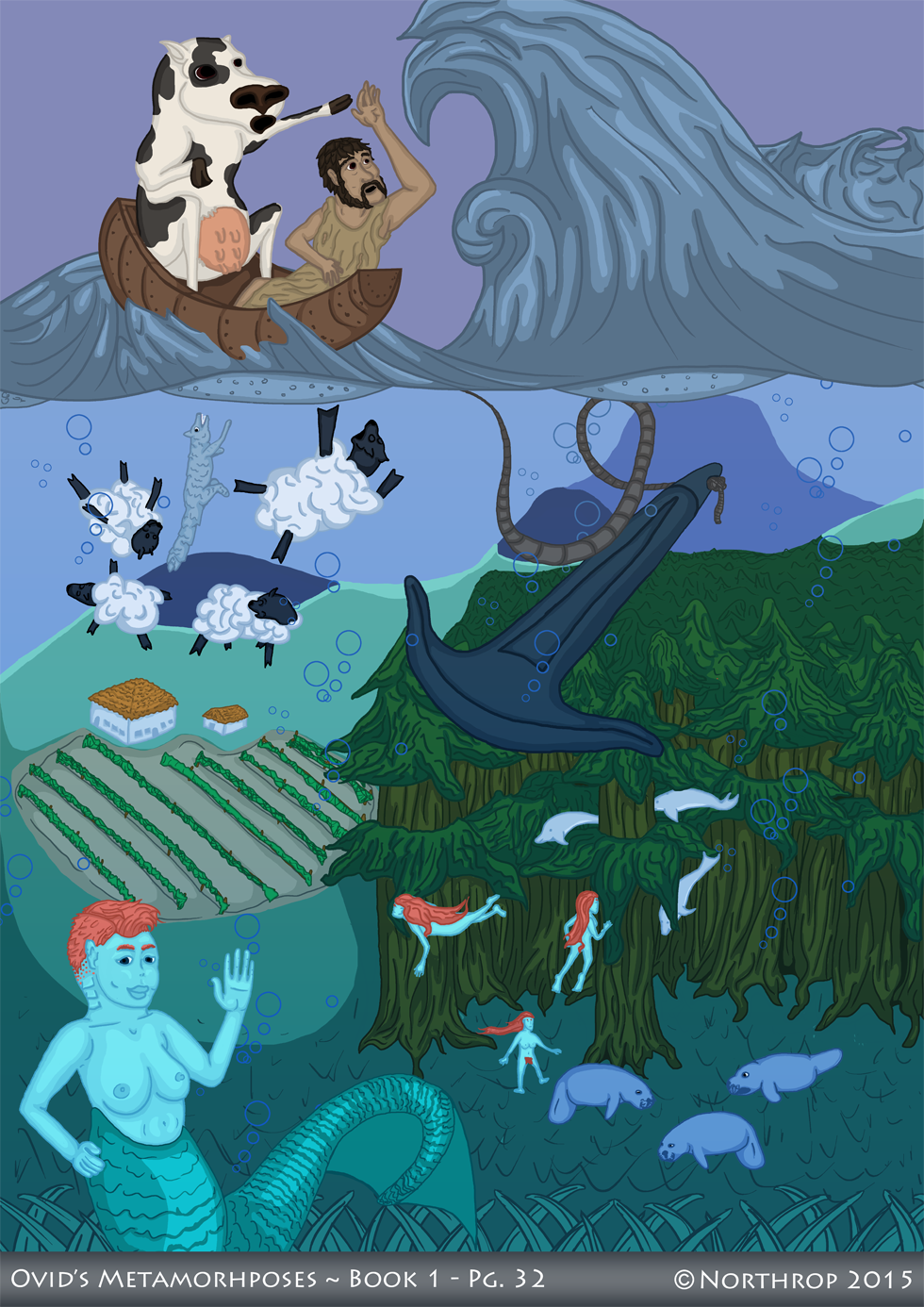IAMQUE MARE ET TELLUS NULLUM DISCRIMIN HABEBANT;
OMNIA PONTUS ERAT, DEERANT QUOQUE LITORA PONTO.
OCCUPAT HIC COLLEM, CUMBA SEDET ALTER ADUNCA
ET DUCIT REMOS ILLIC UBI NUPER ARARAT;
ILLE SUPRA SEGETES AUT MERSAE CULMINA VILLAE
NAVIGAT, HIC SUMMA PISCEM DEPRENDIT IN ULMO;
FIGITUR IN VIRIDI, SI FORS TULIT, ANCORA PRATO,
AUT SUBIECTA TERUNT CURVAE VINETA CARINAE;
ET, MODO QUA GRACILES GRAMEN CARPSERE CAPELLAE,
NUNC IBI DEFORMES PONUNT SUA CORPORA PHOCAE.
MIRANTUR SUB AQUA LUCOS URBESQUE DOMOSQUE
NEREIDES, SILVAS TENENT DELPHINES ET ALTIS
INCURSANT RAMIS AGITATAQUE ROBORA PULSANT.
NAT LUPUS INTER OVES, FULVOS VEHIT UNDA LEONES,
UNDA VEHIT TIGRES; NEC VIRES FULMINIS APRO,
CRURA NEC ABLATO PROSUNT VELOCIA CERVO;
QUAESITISQUE DIU TERRIS UBI SISTERE POSSIT,
IN MARE LASSATIS VOLUCRIS VAGA DECIDIT ALIS.
OBRUERAT TUMULOS IMMENSA LICENTIA PONTI
PULSABANTQUE NOVI MONTANA CACUMINA FLUCTUS.
MAXIMA PARS UNDA RAPITUR; QUIBUS UNDA PEPERCIT,
ILLOS LONGA DOMANT INOPI IEIUNIA VICTU.
AND NOW THE SEA AND LAND ARE INDISTINGUISHABLE;
EVERYTHING WAS SEA, AND EVEN THE BEACHES WERE GONE.
ONE MAN SITS ON A HILL, ANOTHER IN HIS CURVED BOAT
AND PLIES HIS OARS OVER FIELDS HE HAD RECENTLY PLOUGHED;
ANOTHER SAILS OVER FIELDS AND THE ROOFS OF SUBMERGED VILLAS,
WHILE THIS ONE FISHES FROM THE TOP OF AN ELM;
HIS ANCHOR LANDS ON SOMEONE’S LAWN, IF IT MANAGES TO LAND,
OR HIS CURVED KEEL BUMPS AGAINST A SUNKEN VINEYARD;
AND, WHERE THE SLENDER GOATS JUST GRAZED,
NOW DEFORMED SEA-COWS LAY THEIR BODIES THERE.
THE NEREIDES WONDER AT THE GROVES AND CITIES AND HOUSES UNDER WATER,
DOLPHINS TAKE TO THE FORESTS
BUMPING UP AGAINST THE HIGH BRANCHES OF THE OAK TREES.
THE WOLF SWIMS WITH THE SHEEP, AND THE WAVES TAKE THE LIONS
AND THE TIGERS; THE FORCE OF THE BOAR’S LIGHTNING FAILS HIM,
AS DO THE SWIFT LEGS OF THE STAG AS HE IS CARRIED ALONG;
AFTER SEARCH A LONG TIME FOR LAND WHERE THEY MIGHT REST,
THE BIRDS FALL EXHAUSTED INTO THE OCEAN.
THE IMMENSE LIBERALITY OF THE SEA NOW COVERS THE HILLS
AND NEW WAVES BEAT AGAINST THE PEAKS OF MOUNTAINS.
MOST THINGS ARE SEIZED BY THE WAVES; THOSE THE WAVES SPARE
ARE TAKEN BY LONG THIRST AND WANT OF FOOD.
Wow, that one took a loooong time: I’m really sorry for the delay everyone! I wanted to have a big composition to depict these lines, and it kinda snowballed. See, Ovid jam packed the flood with imagery; to make matters worse (for me), he deliberately drew on the absurd. His point is to make his reader realise the flood is a return to Chaos, a non-sensical amalgamation. For this, he draws on ancient literary theory. The most telling lines are 302-3: […] dolphins take to the forests/ bumping up against the high branches of the oak trees”. Compare those lines to the advice of the Augustan poet, Horace, in his work on poetry, Ars Poetica:
“QUI UARIARE CUPIT REM PRODIGIALITER UNAM,
DELPHINUM SILUIS ADPINGIT, FLUCTIBUS APRUM.
IN UITIUM DUCIT CULPAE FUGA, SI CARET ARTE.”
“A MAN WHO WISHES TO UNNATURALLY VARY A THEME
PAINTS A DOLPHIN IN THE FOREST, [OR] A BOAR RIDING THE WAVES.
FEAR OF BLAME LEADS TO VICES, IF THE ART IS LACKING.”
(Horace, Ars Poetica 29-37)
Sound familiar? Horace actually has a lot of these sorts of admonitions that compare the world of visual art to literature. Ovid plays with the concept of visual and literary arts here and elsewhere, actively seeking a chance to break the rules in an unassailable way. In fact, the entire beginning of his Metamorphoses is an exercise in messing with conventional poetic wisdom.* In the lines following this selection, Horace admonishes his pupil to not try to depict the whole story when writing poetry, but to give the reader a snippet of the whole thing. This was ancient poetic dogma, even to Horace and Ovid. However, Ovid puts two fingers up at conventional wisdom when he chooses to start his story from the beginning – the very beginning… of time! Ovid wants you to know: the Metamorphoses is not your grandpa’s epic – this is a project unlike any other, a world where anything can happen… even dolphins swimming among some trees.
*Horace is not, in fact, as strict as his admonitions in the Ars Poetica pretend. He is also not the originator of such dogma: Aristotle already layed out fundamentals of art in his Poetics, which Horace seems to react to. Later Hellenistic authors, such as Callimachus, also added new edicts and revisions to poetry theory before Horace sat down to write.

Discussion ¬